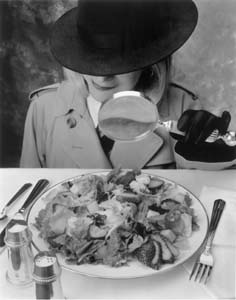![[MetroActive Dining]](/dining/gifs/dining468.gif)
![[MetroActive Dining]](/dining/gifs/dining468.gif)
[ Dining Index | Metro Santa Cruz | MetroActive Central | Archives ]
Size Matters
Bigger is better--according to American diners, American restaurant owners and antiquated American dining propaganda
By Christina Waters
IT'S BEEN BREWING for a long time, my problem with the rapidly expanding portion size in what I'll loosely call the American dining experience. But it was during the past month that the problem exploded. I'd just returned from visiting a Santa Fe restaurant where a slab of bison shank threatened to engulf my entire table. The week before, a salad large enough to stuff a mattress for the Jolly Green Giant had scared me out of my wits. But the final blow was struck by a 24-ounce steak that literally draped off both sides of my plate at a recent East Coast grill encounter. A steak so large that two of us ate as much as we could in a single forage, feeding from it like ravenous cheetahs mauling a slab of wildebeest. And there was still enough left the next day for steak sandwiches for six people.
I have had enough of this dementia, this out-of-control mania for oversized portions, this blind, mindless equating of quantity with quality. Bigger does NOT mean better. It means bigger. And now that we have some common ground, English language-wise, let's move to the meat of the matter.
Many factors are to blame for this sorry situation in which people over and over again feel that they've dined well if they've stuffed themselves. How many times have you heard someone praise a restaurant with this epithet: "They give you huge portions"? Or "You really get a lot of food." What they don't say is that half that food went back to the kitchen after this ritual display of excess, greed and sheer visual overkill. Or that half the food went home in a doggy bag, where it was reheated--not exactly a flavor-enhancing technique-- for another meal. Consumers are partly to blame, demanding the entire plate surface be covered with food or else they feel cheated. This is quite likely a mass case of low self-esteem with food being used to compensate for (a) not being loved as a child, (b) not getting laid as a teenager, and/or (c) not living up to Walt Disney's idea of adult success.
Wake up, folks. The Depression is over. Eating everything on a plate that contains enough food for a small village will not work some global voodoo and prevent children in Sarajevo from starving--would that it could. Your mother will not keel over dead if you fail to consume 3,500 calories at a single sitting.
Another factor is sheer capitalist greed. By throwing in a bowl of soup from the pot already simmering or a salad using pre-prepped lettuce, a restaurant can charge the consumer an extra $6 per entree. The consumer is thrilled to get such "a deal"--as in, "you get soup and salad too!" But is the consumer really hungry for soup and salad? Does that soup and salad actually get eaten, along with a whole entree? Why not simply charge less and let patrons dine on a portion they feel physically and aesthetically comfortable consuming?
I have often been intimidated by the sheer size of dishes presented. Gamely digging in, I think, how can I possibly eat all this food? "Still working on that?" a waiter recently asked me, reminding me how all too often just finishing a dish is indeed a chore. The inner mom haunts us all, urging us to finish all our food, reminding us that she (metaphorically) made this food for us and if we love her we have to eat it all.
How many times have you overheard restaurant conversations about starting that diet tomorrow, as the speaker orders dessert and then happily squeals "Isn't it big?" about a piece of tiramisu the size of the Vatican.
Perhaps the American obsession with enormous meals--and it is very much bound up in our national identity to insist on the big, the super, the jumbo--began before World War II when more Americans made their living by physical work. You needed to consume eggs, bacon, biscuits, butter, jam and pancakes if you'd just milked 40 cows, harvested a field of hay and slaughtered a dozen pigs. And after a hard day digging ditches and mending fences, 12,000 calories of steak and potatoes made much more sense than it possibly could after logging onto the Web and making some power phone calls. Trading sweat for stress, we still feel we must eat as if we're preparing to plow the back 40.
Perhaps a reality check is in order, and restaurants that offer petite or half-portions are to be congratulated. If the trend toward size intimidation continues, "food" will be just another four-letter word.
[ Santa Cruz | MetroActive Central | Archives ]
Copyright © Metro Publishing Inc. Maintained by Boulevards New Media.
![]()
 Sizing It Up: Portions in America's dining culture continue to rise, as do the waistlines of American diners.
Sizing It Up: Portions in America's dining culture continue to rise, as do the waistlines of American diners.
From the July 30-Aug. 5, 1998 issue of Metro Santa Cruz.